If in 1922 the IoM TT races were regarded as the premier motorcycling speed event, then the ACU Six Days Trials was the leading reliability test. Riders strived for gold medals, makers to showcase new models and organisers endeavoured to run a fair but tough trial. Simple? Well, actually not so simple, and controversy reigned supreme.
Words: RICHARD ROSENTHALPhotography: MORTONS ARCHIVE
Controversy
Enjoy more Classic MotorCycle reading in the monthly magazine.
Click here to subscribe & save.
Logically, the thorny subject of controversy should conclude this feature, but here it sets the scene and proves – as we all know – you can only please some of the people, some of the time…
Past controversy shaped this 1922 event, with the ACU bowing to the pressures of the trade and entrants, a sector which ended the event reasonably happy. But in so doing, the ACU annoyed a large number of spectators.
The 1921 ACU Six Days Trials featured many special tests, some of which in modern terms would be regarded as ‘trick’, but the road work – in effect the testing backbone of these events – was too easy.
A year later, riders hoped for less freakish tests, while makers wanted tougher roadwork to prove the machines. The promotional kudos following completion and a medal from the ACU Six Days Trials was every bit as important to manufacturers as a good IoM TT result.
The factory knew a successful Six Days equalled increased sales, as buyers followed the event in detail, using it to guide the choice of their next season’s model.

Usually, compromise satisfies no one, but for once this tightrope-like act taken by the ACU worked for most riders and factories. But the general public was dissatisfied.
While they considered the road route ‘trying’ and a few of the hills truly testing, the points scoring system, or rather the bands dividing the gold, silver and bronze award winners, was considered by the public as too wide.
With a nod to this thought, The Motor Cycle likened the ACU scoring system to a wide ratio gearbox, adding the ACU should have used a close ratio gearbox as its model…
Endeavouring to appease the disgruntled public, the Press detailed the points scoring system where all riders were awarded 480 marks at the start of the trial.
Marks were lost for failing or not attempting tests, arriving late or early at check points and the machine’s condition at the event’s end, with points lost for general untidiness, worn components such as steering head or wheel bearings, running, gearbox efficiency and more.
Riders were also able to gain marks at certain tests and on the 25 lap speed trial at Brooklands.
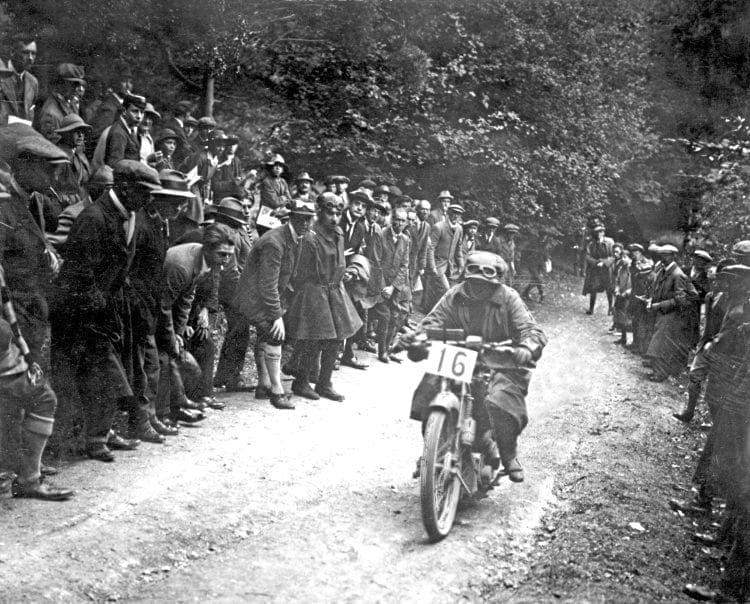
It was therefore possible for riders to finish the event with more marks than at the outset.
Equally, riders may fail on two or even three tests yet gain enough marks elsewhere to pull themselves back into a gold medal position, for example.
This led to rule manipulation by a few who did not attempt a climb or two they’d struggle on in the knowledge they could pick up extra marks elsewhere to ensure they scraped into that gold medal band.
In a further attempt to appease the public’s mutterings, the Press endeavoured to show how some gold medals awarded were more meritorious than others.
And famously employed the paragraph: “To give credit where credit is due, we will endeavour to distinguish between ‘100%’ golds and ‘the only-just-got-away-with-it’ golds.”
All too complicated for the spectators, who held their hands up, threw the towel in and continued grumbling that there were too many gold medals awarded and how could riders end up with up to 14 more marks at the trials’ end than at the outset?
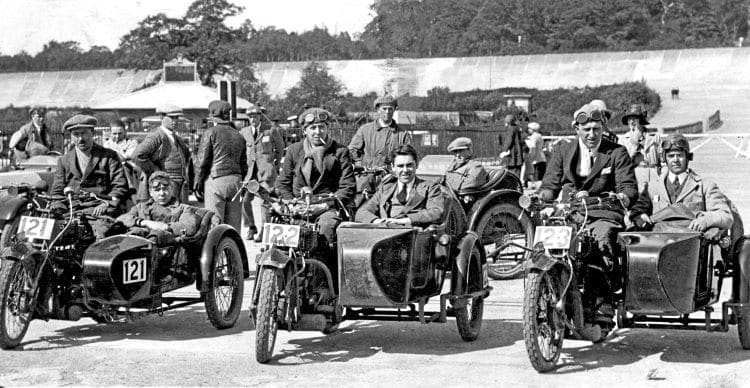
Frank Giles (800cc AJS outfit) did exactly this, finishing the week on 494, 14 more than his awarded 480 starting marks.
Despite these shenanigans, the 1922 ACU Six Days Reliability Trials proved a testing event with some tough rather than freak special tests, and five days of hard roadwork linking them at an average of 20mph for much of the week.
And, of course, the 25 laps (68 miles) of Brooklands, plus a climb of Test Hill and the machine examination on the final day proved too testing for a handful of machines.
Leading its feature ‘Analysing the Six Days Trials’ with the standfirst: “Unequal performances which gained equal awards. Lessons to be learned – by prospective buyers and motorcycle designer – from the trials,”The Motor Cycle cleverly summed up the event.
Signing on
Officially the trails began on Monday, August 21, at York, as riders fired up in glorious sunshine and headed north on what is now the B1363 for Stillington and then the first test on White Horse Hill.
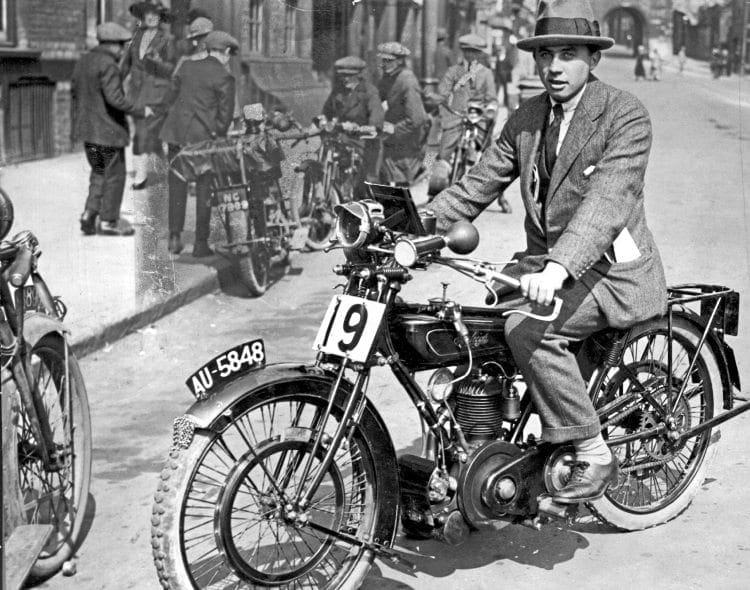
But for all competitors, the annual event began a day or more earlier. Factory teams, club assisted riders and privateers arrived in York late the previous week, ready for the ‘official bit.’
Of the 144 entries, 142 riders followed their machines as they were weighed, scrutineered in detail and sealed on the Sunday. Along with completing paperwork and sorting route information, it proved a long arduous day, during which the hype of the event clearly affected a sizeable number of new and old hands.
Spectators mingled during the summer’s day on the look out for new models – and they weren’t disappointed.
The James Cycle Company entered two brand new 349cc singles for J Lidsgate and G Kimberley (both secured gold medals), while George Brough proudly posed with his gleaming new 976cc Brough-Superior Special Sports, informing all it was guaranteed for 80mph.
Raleigh entered new chain drive models – Connaught, near new examples. The lightweights, including Levis, Radco, Sun Vitesse (rotary-valve two-stroke), and Allon attracted lots of interest, with the Press focusing on the smallest machine in the trials, the 169cc JES two-stroke with four-speed gearbox, but no clutch.
At previous ACU trials, riders had lost marks for noisy, ineffective exhaust systems. Many were clearly nervous in case their machines were too loud and they lost unnecessary marks.
The ‘works’ Raleigh lightweights employed a transverse silencer under the magneto and another to the rear of the machines; Westwood Wills fitted an Argus silencer as an extra to the tailpipe of his Powell while GE Austin plumbed the twin pipes of his Coventry Victor into an adapted Argus unit. Others used ingenious additions to the standard systems.
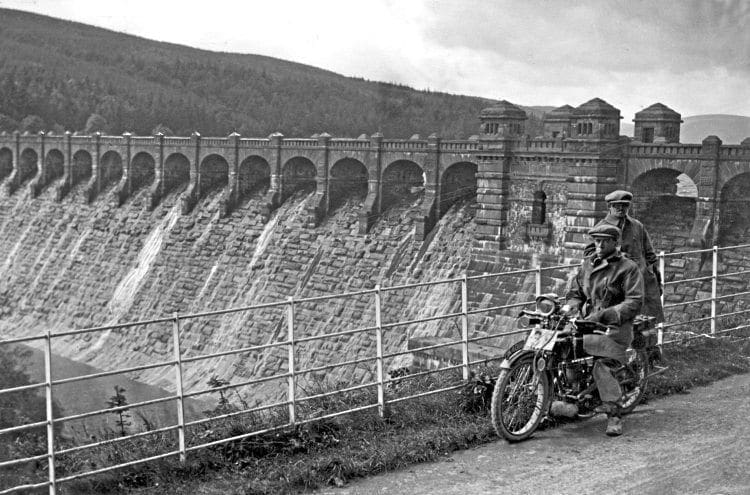
Apart from the JES, four-speed gearboxes were found on a number of machines, including WN Clayton-Russell’s 633cc Big Four Norton, which sported a Dureff four-speed chain gearbox.
And P&Ms, Dots and Morgan three-wheelers were found with four gears. Competing in the same class as the sidecar outfits were the Morgans, a Scott Sociable, one TB driven by FS Spouse and an LSD.
There were only two non-starters – Mr Packman (349cc P&P) and GE Cuffe (698cc Metro-Tyler) – and four rider replacements, including R Evans on the factory Raleigh in place of Hugh Gibson and Charlie Hough for Eric Williams on one of the works AJSs.
Trialling times
Monday dawned a superb summer’s day, which should have lifted spirits and lightened the responsibility many riders felt weighing on their shoulders.
But even after a dozen or more settling miles, the butterflies remained – the Press likened their situation to stage fright.
The sandy, mile-long White Horse Hill Climb, though strewn with some boulders, should have troubled no one, but the spectators ‘enjoyed’ many calamities.

There were a few stunning ascents, including the neat style of Mrs O M Knowles (349cc AJS) and the tidy climbs of the JES, although it stopped briefly.
Someone always has to play to the gallery and on this occasion it was the AJS men Charlie Hough and HF Harris, who powered up the hill as if racing up Snaefell Mountain, spraying sand to all corners.
After White Horse Hill Climb, the riders descended Sutton Bank with care and later they journeyed onto Rosedale Abbey Bank, which accounted for many failures.
Riding round those who had stopped, Charlie Hough, George Dance (499cc Sunbeam) and other leading riders took no prisoners, earning huge cheers from the gathered crowd.
Fresh from his IoM Senior TT win, Alec Bennett gave his 499cc Sunbeam the big fistful, only to skid through 180° at the gulley, to record his only failure in an otherwise unblemished week.
After Abbey Bank, riders encountered more stiff tests before a colonial stretch took them to the twin water splashes at Hutton-le-Hole and then a circuitous route back to York for lunch.
The afternoon course via Sheffield, Barnsley and Asford included many long, top gear road stretches and easier tests before the show bedded down in Buxton for the night.
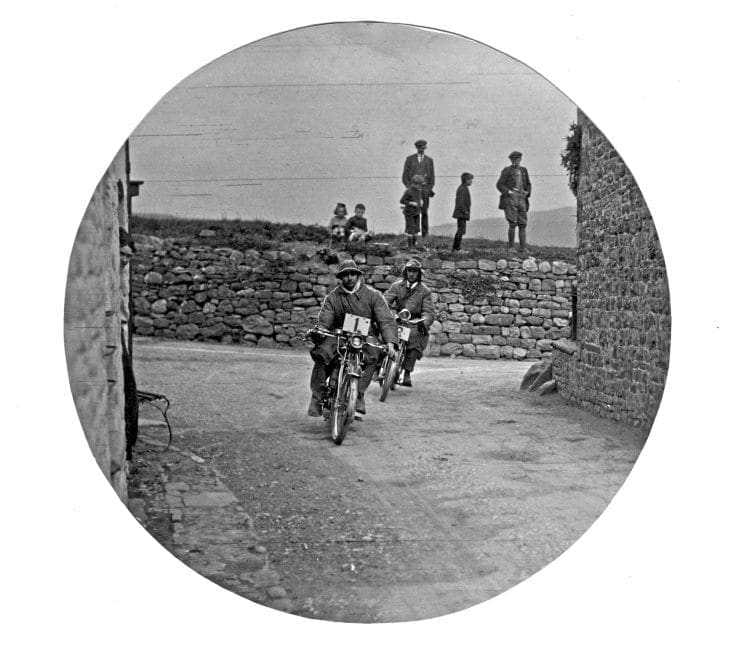
Following early rain, entrants awoke to mist shrouding the spa town, unsettling for some, but overall the day’s tests were easier than on Monday. Despite the easier going, two outfits – IP Brettell (348cc Connaught) and WN Clayton-Russell – crashed heavily with serious injuries to both drivers.
The direct route to the lunch stop at Rudyard was just 17 miles, but by skilful employment of local lanes the ACU stretched this to 66 miles!
Throughout the day, riders encountered long, steeps drags up which many larger mounts blasted, but a few lightweights struggled, including the JES which seized momentarily, then got going again.
If the day’s riding pleased many, the night’s accommodation in and around Shrewsbury didn’t, with officials and support teams billeted in every spare bed across town.
Not great if you were meeting up with mates for an evening beer or two. And the landladies and landlords operated differing rules.
One landlady informed her well-known ace lodger he must be back and in bed by 9pm, yet another returned early to his billet only to discover his hostess at the pictures until 10.30pm – she assumed lads would be lads…
Wednesday’s 156 mile run via Welshpool, the Bala lunch stop and Knighton to the overnight stop at Llanddrindod Wells held minimal horrors.

Test hills ,including Long Mountain and Hirnant Pass, challenged few and more riders had settled into the reliability trials fun to scorch test hills, including Reg Brown and Tommy de la Hay on their Sunbeam outfits.
However, if there’d been an award for the fastest ascents it would have been a close run thing between W D Pugh’s 989cc Harley-Davidson and the 739cc Martinsyde of Brooklands racer GF Bainbridge.
The ACU missed a trick by not observing Welshpool Hill as it halted a few, including leading riders, while Bwlch-y-Groes proved the only stinker of the day.
Again the AJSs climbed with aplomb, with Hough again the fastest, Harris a little slower, with Mrs Knowles turning up the wick aboard her 2¾hp model, blasting by a number of slower entrants on the ascent.
The run from the overnight stop to Abergavenny for lunch and then Gloucester for the next sleepover should have troubled few, but persistent heavy rain made easy tests much harder.
The wet weather sidelined some temporarily en route, including Mrs Knowles, who was observed hastily drying the magneto of her AJS – still, she fared better than her husband, who retired his Norton with a bust gearbox.
Such was the ease of some climbs at least one observer, Dr Hopwood, was trying to distinguish between footing to maintain balance – allowed – and footing to maintain forward motion, which was not allowed. During the day, five riders retired and a seemingly bored Jack Watson-Bourne took over the mount of George Brough, who had become ‘indisposed.’
Friday’s route took the trial to Brooklands for the Saturday speed testing via Stroud, Tetbury, Oxford (lunch), High Wycombe, Windsor, Staines and then onto Weybridge and Brooklands.
Whether it was relief that the end of the road work was near, or the thrill of riding on the banked Brooklands track, or acts of the Gods, some riders were seen carelessly crashing, overshooting junctions, wobbling on the straights and even tumbling off on easy hairpins…
Arguably the stiffest test of the day was Alms Hill, where the large-gathered crowd enjoyed the racing ascents of George Dance, Jack Watson-Bourne, W D Pugh and others.
For once Mrs Knowles took the climb steadily, probably mentally holding her gold medal already, and Mr Westwood-Wills was spotted rubbing his eye with one hand while controlling his 547cc Powell with the other over the hardest stretch.
One of the biggest cheers of the day went up for Geoff Davison, who cheekily changed into top on his 247cc Levis as he crested the Cannons. All good fun.
Despite the challenges of the week-long event, 105 riders lined up in class order to await the starter’s pleasure at Brooklands.
Each class was given an appropriate minimum speed to maintain for their 25 laps, with many exceeding it by a country mile.
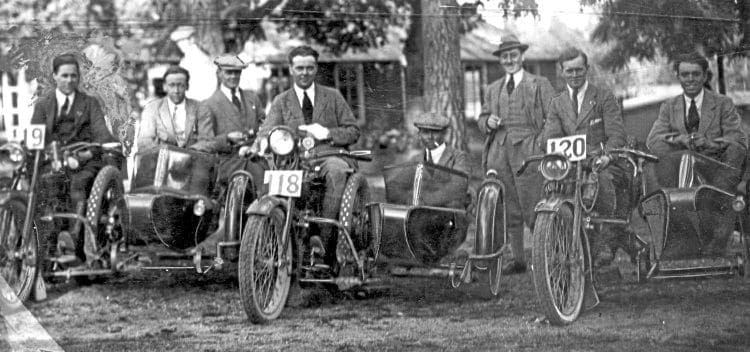
Riders approached the test differently. George Dance announced he was going to take it steady, then didn’t, but was finally outrun by Bainbridge’s Martinsyde, who easily took the unofficial FTD.
Pa Applebee (247cc Levis) was said to have 25 stones in his pocket and jettisoned one every lap, while Mrs Knowles sported a 25 tooth cardboard comb attached to the handlebars of her Ajay, tearing off a tooth per circuit.
The test hill actually challenged few, although Westoood-Wills’ Powell failed with a split belt rim, but having been clean all week he remained certain of gold.
Despite the seeming ease for some during the Saturday, there were six retirements, including the aptly named T Buckle (748cc FN), whose tyre burst at speed causing him to crash.
A total of 79 gold medals were awarded, with recipients including the rapid AJSs of Harris, Hough and Mrs Knowles.
George Brough still gained gold despite Jack Watson-Bourne taking over his V-twin mid week, and of the team prizes the ultra-quick Sunbeam boys of Dance, Bennett and Cyril Greenwood (son of Sunbeam designer John), with a score of 1458, blasted the opposition into the weeds.
And despite oiling problems at Brooklands, the smallest machine of the event, the JES, completed the trial with five special test failures as well as struggling on time at Brooklands to earn one of seven certificates awarded. And so ended a mixed event.
Read more News and Features at www.classicmotorcyle.co.uk and in the latest issue of The Classic Motorcycle – on sale now!
Advert
 Enjoy more The Classic MotorCycle reading in the monthly magazine. Click here to subscribe.
Enjoy more The Classic MotorCycle reading in the monthly magazine. Click here to subscribe.



